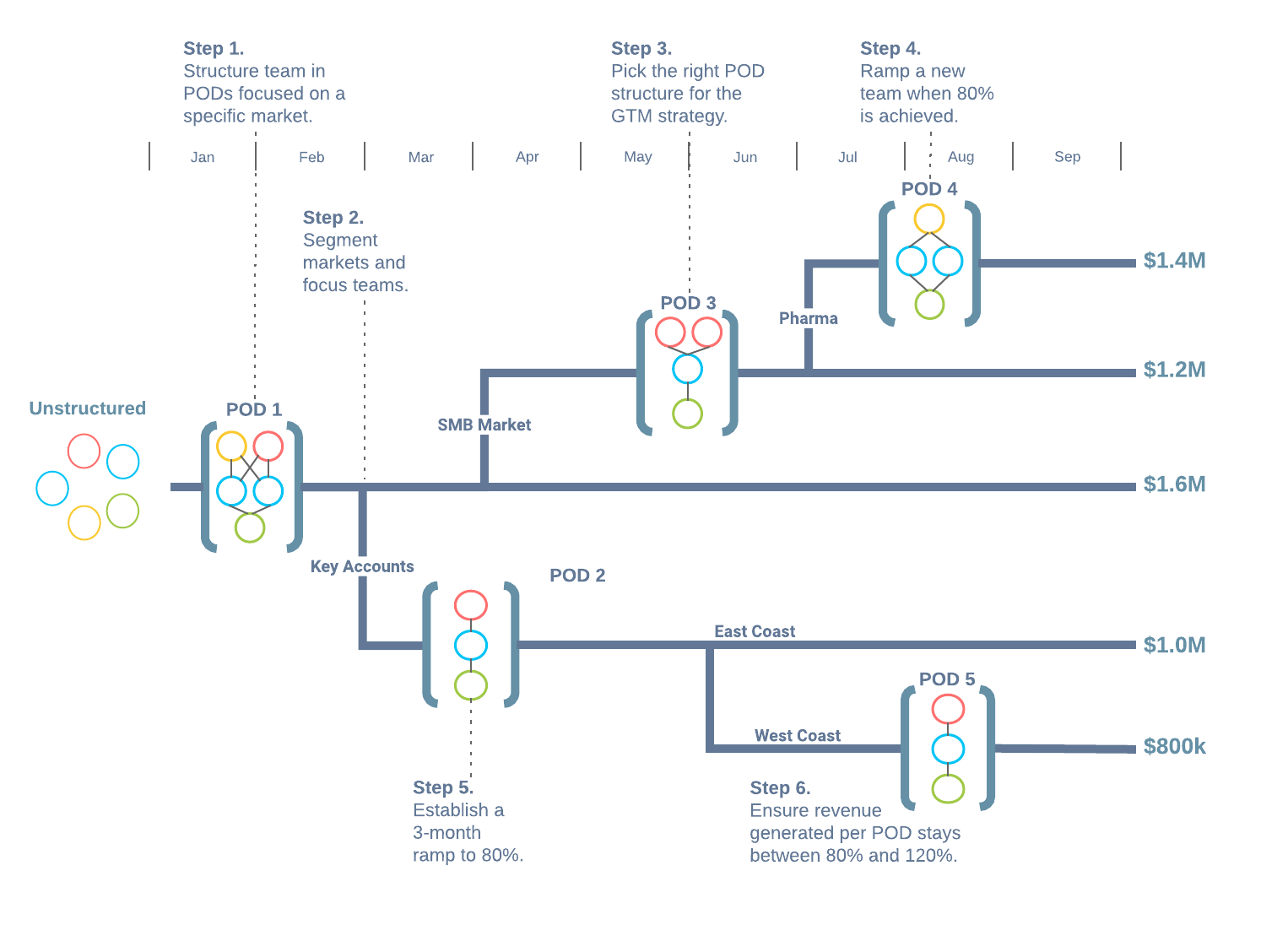Your sales team structure is the foundation of your operations. If the foundation is weak, the entire sales process will suffer. As such, the way you design and structure your sales organization can have lasting consequences for your business’s long-term success.
But how should you structure your team? What model is best?
There is no one-size-fits-all model for sales orgnization structures. The key is to find one that aligns with your business’s current operations and objectives, and that can move your team effectively into the future.
Take a look at three common sales team models as well as best practices for creating a successful organization.
The assembly line
The assembly line (also known as the hunter-farmer model) is one of the most common sales structures, particularly for small to medium-sized businesses and SaaS startups. In this model, each team member has a specific role or function within the sales cycle.
Just as in a traditional manufacturing assembly line, the strategy is to move through the sales cycle from lead generation and nurturing to closing the sale by passing off tasks to a different sales member at each stage. In other words, one person might focus on identifying leads and another on nurturing or closing them.
A typical structure will include the following roles or teams:
- Lead generation
- Sales development (SDRs)
- Closing (account executives)
- Customer success/account management
To go back to the hunter-farmer analogy, the hunters are those who focus on lead generation and prospecting (i.e., hunting for new clients), and the farmers are those who focus on current customer success and satisfaction. They nurture the clients to increase lifetime value and promote upselling opportunities.
Strengths
The assembly line design is popular for good reason: It’s easy to understand and can work across multiple industries and products. Additionally, the assembly line can improve efficiency, make it easier to identify issues along the pipeline, and develop high skill proficiency for team members.
Limitations
The hunter-farmer sales team structure does have some disadvantages. For the model to work most effectively, you will need a larger team of at least five or six people. Additionally, though specialized roles can increase efficiency, it also poses a challenge for communication and alignment across team functions.
The island
This is the most straightforward sales organization structure. In this model, there is an owner or manager at the top who oversees multiple sales reps. Each sales rep is individually responsible for each stage of the sales process (from lead generation to close).
The island model is most common in traditional sales operations like finance and real estate.
Strengths
Perhaps the most significant advantage of the island structure is its simplicity. The structure is easy to design and implement and requires minimal management. It works best with simpler sales processes and thrives in industries or environments that encourage competition and independence.
Limitations
Because each team member works independently, tracking sales metrics is a challenge. Additionally, competition between salespeople can work against the business if it leads to a toxic sales environment.
Depending on the industry and business, this model can work on a large scale. But it can also make scaling your business difficult as each person has individual processes and strategies. Therefore, aligning your sales organization is a challenge within this model.
The POD
Recommended by Jacco van der Kooji, founder of Winning By Design, the POD structure is becoming increasingly popular, particularly among SaaS organizations.
At the team level, the structure works similarly to an assembly line where each member of the group plays a specific role. However, instead of one large team, there are multiple groups (or pods) each tasked with selling to a particular set of customers.
A POD is typically organized by industry vertical, geography, territory, or product.

Strengths
The POD model takes advantage of the assembly line efficiency while strategically assigning people (and groups) to the customer base that they (hopefully) will be most successful with.
By diversifying the team, the POD also reduces some of the issues that arise from human error. In other words, team members ideally have complementary strengths and weaknesses to ensure more effective sales (i.e., one person’s weakness is another’s strength).
The POD sales team structure is also more flexible and is a good choice for growing organizations looking to efficiently and effectively scale their sales operations.

Limitations
Because the POD is team-based, it can be a challenge to motivate sales reps individually. Additionally, group-based selling can create opportunities for conflict if individuals don’t work well together. Conflict can lead to inefficiencies with the sales cycle and challenges for the sales operations team.
Creating a culture of success
How you structure your sales organization will depend on your specific business, market, and goals. Whatever model you choose, you'll need to imbue the organization with a culture that promotes high performance.
Without culture, your structure can’t reach its full potential. Here are two important ways you can build a winning culture into the foundation of your sales organization.
1. Clearly define sales roles
You can have an elegant sales structure, but if your team members don’t understand their roles and responsibilities, your business will suffer.
Whatever model or approach you implement in your sales organization, make sure each person has a clearly defined role to prevent confusion, inefficiencies, and redundancies.
One way to ensure everyone is on the same page is to use Lucidchart. Lucidchart is a diagramming platform that helps sales teams document and track their sales processes and organization. Team leads and sales reps can use Lucidchart to map out the sales team structure and maintain updated versions of each account.
Not only will Lucidchart streamline handoffs and clarify rules of engagement, but it will also serve as a resource for quickly onboarding new hires and relaying key data to reps who adopt new accounts.
By documenting each step of the sales process and mapping key stakeholders and individual roles, everyone can stay on the same page even in times of change.
2. Promote an environment of learning
A lack of training is one of the biggest problems facing sales organizations today. In fact, according to Kurlan Associates, as many as three-quarters of the people who work in sales “cannot execute.” In other words, they’re ineffective.
But it doesn’t have to be this way!
For most people, the issue lies in lack of training—not a lack of ability. When sales organizations prioritize coaching and bake it into their sales structure, the whole organization thrives.
That is why coaching should be one of the critical functions of any sales manager. In fact, a study by OMG found that when sales managers invested 50% of their time to coaching, salespeople scored 28% higher in sales competency measures than those who are managed by people who train less.
Lucidchart is a powerful addition to a sales manager’s toolbox. Managers can use Lucidchart to onboard new hires and train sales reps on new accounts more quickly and effectively. Plus, our Salesforce integration and sharing features make it easy to transfer knowledge between team members and departments, so no one is left behind.

Once you know which sales team structure you want to use, learn the steps in the company reorganization process.
Read moreAbout Lucidchart
Lucidchart, a cloud-based intelligent diagramming application, is a core component of Lucid Software's Visual Collaboration Suite. This intuitive, cloud-based solution empowers teams to collaborate in real-time to build flowcharts, mockups, UML diagrams, customer journey maps, and more. Lucidchart propels teams forward to build the future faster. Lucid is proud to serve top businesses around the world, including customers such as Google, GE, and NBC Universal, and 99% of the Fortune 500. Lucid partners with industry leaders, including Google, Atlassian, and Microsoft. Since its founding, Lucid has received numerous awards for its products, business, and workplace culture. For more information, visit lucidchart.com.

